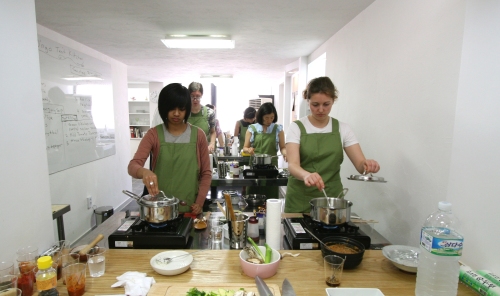Getting savvy with Korean cooking early on helps vegetarians adapt to Korea
With a homely interior, featuring upside down teacups strung as lamp shades, Itaewon’s Honest Loving Hut is the perfect place to tuck into that hearty meal synonymous with Western comfort food ― a burger.
But this one comes served guilt-free: it’s vegan. Atop the wholegrain bun sits lettuce, a slathering of vegan mayonnaise and a moist, plump tofu burger, garnished with fresh tomato relish. Herb-seasoned potato wedges are served on the side.
This is the only Loving Hut in Korea to exclusively serve Western food, but the rapidly expanding franchise ― often serving vegan versions of Korean dishes ― is a favorite among the country’s growing vegan and vegetarian population.
In at the deep end
Most foreigners’ initiation to Korea comes sat around a BBQ with coworkers, sharing drinks and endless cuts of meat. This can be hard for people with dietary restrictions hoping to assimilate without much ado. So for practical reasons, some find themselves making exceptions.
Jill Murray, vegan for a year, struggles when out and about. “I sometimes feel like a burden to my friends here because there are so many restaurants that only serve meat,” she explained.
Rae Dohar did make changes in her first few weeks and ate seafood, egg and some dairy cookies. “I wanted my co-teachers to understand that I was appreciative of their culture and willing to try new things.” But, now they know her better, she said they are understanding.
As long as you are sensitive and polite with your requests, most find restaurants are happy to accommodate. “Cuisine here is very personal,” said Vanessa Burke, who recommends not picking unwanted parts out of your food. “I have yet to offend because I’ve learned a lot of Korean, know what ingredients are in what and am specific of my lifestyle choices.”
Many say knowledge of Korean is vital ― to get started, ask a Korean friend to write down a list of key words and phrases which you can produce at restaurants.
Still, it is not always clear what exactly has been used. “Being a vegan in Korea is quite challenging as a result of all the hidden ingredients in dishes that seem like they would be free from animal ingredients,” explained Dr. Colin Venters.
As well as soups which use animal-based stocks, the Korean-staple kimchi is usually made with small pickled shrimps.
Despite these challenges, many have strong moral and environmental reasons for their diet, and wouldn’t entertain alternatives. Jennifer Howell, for instance, said she has never even been tempted to stray, preferring to appreciate Korean culture in other ways.
“I was clear and firm from the start about being vegan and I have never been pressured by any of my co-workers, who are all Korean. We go out socially and they are always thoughtful to order some kind of side dish that I can enjoy.”
Living in Busan, she finds it easy ― as well as Loving Hut, she also makes simple adaptations in non-vegan places. In Haeundae alone, for example, there are three different Mexican restaurants, where she and her husband can order bean burritos minus the cheese and sour cream. When travelling, she takes her own snacks just in case.
People live happily throughout the country meat/animal-product-free. Mipa Lee, author of vegan blog Alien’s Day Out feels things are getting easier: “As more Koreans are making a conscious effort to eat less meat and more ‘well-being,’ organic, natural and slow foods, I think the demand for vegetarian fare is going up, and businesses are taking notice.”
She is hopeful that the increase in vegetarian and vegan restaurants and Korean cookbooks indicates that the lifestyle choice is becoming more mainstream. “It may be slow progress, but it’s still a step in the right direction,” she said.
With a homely interior, featuring upside down teacups strung as lamp shades, Itaewon’s Honest Loving Hut is the perfect place to tuck into that hearty meal synonymous with Western comfort food ― a burger.
But this one comes served guilt-free: it’s vegan. Atop the wholegrain bun sits lettuce, a slathering of vegan mayonnaise and a moist, plump tofu burger, garnished with fresh tomato relish. Herb-seasoned potato wedges are served on the side.
This is the only Loving Hut in Korea to exclusively serve Western food, but the rapidly expanding franchise ― often serving vegan versions of Korean dishes ― is a favorite among the country’s growing vegan and vegetarian population.
In at the deep end
Most foreigners’ initiation to Korea comes sat around a BBQ with coworkers, sharing drinks and endless cuts of meat. This can be hard for people with dietary restrictions hoping to assimilate without much ado. So for practical reasons, some find themselves making exceptions.
Jill Murray, vegan for a year, struggles when out and about. “I sometimes feel like a burden to my friends here because there are so many restaurants that only serve meat,” she explained.
Rae Dohar did make changes in her first few weeks and ate seafood, egg and some dairy cookies. “I wanted my co-teachers to understand that I was appreciative of their culture and willing to try new things.” But, now they know her better, she said they are understanding.
As long as you are sensitive and polite with your requests, most find restaurants are happy to accommodate. “Cuisine here is very personal,” said Vanessa Burke, who recommends not picking unwanted parts out of your food. “I have yet to offend because I’ve learned a lot of Korean, know what ingredients are in what and am specific of my lifestyle choices.”
Many say knowledge of Korean is vital ― to get started, ask a Korean friend to write down a list of key words and phrases which you can produce at restaurants.
Still, it is not always clear what exactly has been used. “Being a vegan in Korea is quite challenging as a result of all the hidden ingredients in dishes that seem like they would be free from animal ingredients,” explained Dr. Colin Venters.
As well as soups which use animal-based stocks, the Korean-staple kimchi is usually made with small pickled shrimps.
Despite these challenges, many have strong moral and environmental reasons for their diet, and wouldn’t entertain alternatives. Jennifer Howell, for instance, said she has never even been tempted to stray, preferring to appreciate Korean culture in other ways.
“I was clear and firm from the start about being vegan and I have never been pressured by any of my co-workers, who are all Korean. We go out socially and they are always thoughtful to order some kind of side dish that I can enjoy.”
Living in Busan, she finds it easy ― as well as Loving Hut, she also makes simple adaptations in non-vegan places. In Haeundae alone, for example, there are three different Mexican restaurants, where she and her husband can order bean burritos minus the cheese and sour cream. When travelling, she takes her own snacks just in case.
People live happily throughout the country meat/animal-product-free. Mipa Lee, author of vegan blog Alien’s Day Out feels things are getting easier: “As more Koreans are making a conscious effort to eat less meat and more ‘well-being,’ organic, natural and slow foods, I think the demand for vegetarian fare is going up, and businesses are taking notice.”
She is hopeful that the increase in vegetarian and vegan restaurants and Korean cookbooks indicates that the lifestyle choice is becoming more mainstream. “It may be slow progress, but it’s still a step in the right direction,” she said.

Community
Vegetarian and vegan groups exist around the country for those who want to meet like-minded people or share tips on finding cooking ingredients or new restaurants.
The Seoul Veggie Club started out organizing picnics, restaurant visits and potlucks, but has since extended its activities. This month’s events include a Worldwide Vegan Bakesale on April 30 at Roofers, Itaewon (1-5 p.m.), with all profits donated to the Japan relief effort. An O’ngo vegetarian cooking class is planned on April 16.
Daegu Vegetarian Club is soon to start group dinners, and the Green Consumer’s Alliance organizes a weekly vegetarian dinner there. They discuss the ecological significance of food.
Due to work schedules and other commitments, meet-ups are not ideal for everyone. Kia Veselsky attends Sunday protests against dog meat and raises money through bake sales. The last one, with Lee, raised 1 million won for Animal Rescue Korea.
Hanulvut is a Korean group that shares new finds with the Seoul Veggie Club. It is open to foreigners and can be found on Facebook.
If there is nothing in your area, then start your own, advised Mike Roy, who set up Daegu Green Living to connect foreigners interested in environmentally friendly lifestyles.
Land of plenty
Traditionally, the Korean diet was mostly vegetarian so a good vegetable dish is never far away. Vegetarians will be able to do this more easily than vegans, but there are still plenty of banchan (side dishes), and other Korean foods like bibimbap, to be enjoyed minus the animal products.
Buddhist restaurants offer an array of tasty vegan foods, and can be found all over the country. In Seoul, a whole district of temple food awaits close to Anguk station.
“I know Korean food now far better than I did when I was eating meat, since the limitations you accept by becoming a vegetarian encourage you to seek out new options,” said Roy. He often eats meat-free dinners with his friends, most of which eat meat, and recommends that everyone try a vegetarian restaurant once a week to experience new dishes.
As Koreans’ tastes for international cuisines expand, more veggie-friendly meals can be found ― Indian, Thai and Middle Eastern are most readily available. A Vietnamese Loving Hut has also just opened in Seoul.
Many also enjoy cooking at home, and some groups organize market trips to seek out the best ingredients for this. Nicole Shapiro, a member of Seoul Veggie Club, said although fake meat and vegan cheese are hard to come by, “if you’re flexible enough you can create vegan dishes with what is available instead of (focusing on) what’s not.”
“Buy a rice cooker, immediately ... beans and rice are international,” Howell, vegan for eight years, advised. “Be creative, and don’t give up!”
Costco, foreign food markets, department stores and Loving Hut goods provide variety when added to the fresh local fruit, vegetables and other produce ― especially tofu, which is cheap and readily available.
There are sweet treats to be found too. If ddeok (rice cake) doesn’t quite cut it, Purely Decadent soy ice-cream can now be bought in some Family Marts. Mipa Lee also delivers her Vegan Mint-Chocolate cookies within Korea (see website for details) and Caf Harunohee in Seoul sells her homemade pastries. Sticky Fingers’ branches have a good selection of pastries too.
By Hannah Stuart-Leach (hannahsl@heraldcorp.com)
Useful Links
• The Loving Hut: http://lovinghut.kr/kr
• Sticky Fingers: http://www.stickyfingers.co.kr/
• Alien’s Day Out: http://www.aliensdayout.com/
• Mike’s eco-conscious blog: http://noksaeksari.blogspot.com/
• Recipe ideas: www.vegweb.com
• Vegan food supplier: http://www.vegefood.co.kr/
• Restaurant finder: www.happycow.net












![[Today’s K-pop] BTS pop-up event to come to Seoul](http://res.heraldm.com/phpwas/restmb_idxmake.php?idx=644&simg=/content/image/2024/04/17/20240417050734_0.jpg&u=)





![[KH Explains] Hyundai's full hybrid edge to pay off amid slow transition to pure EVs](http://res.heraldm.com/phpwas/restmb_idxmake.php?idx=652&simg=/content/image/2024/04/18/20240418050645_0.jpg&u=20240419100350)

![[Today’s K-pop] Zico drops snippet of collaboration with Jennie](http://res.heraldm.com/phpwas/restmb_idxmake.php?idx=642&simg=/content/image/2024/04/18/20240418050702_0.jpg&u=)